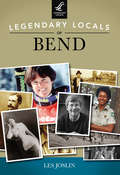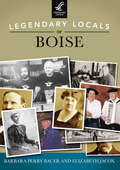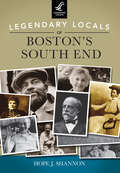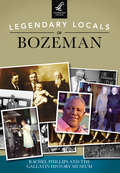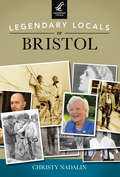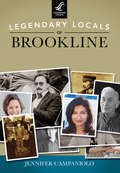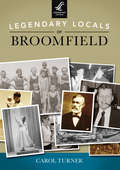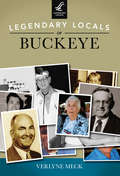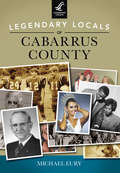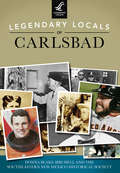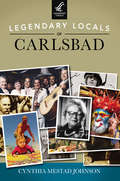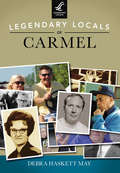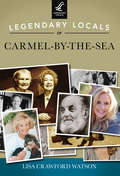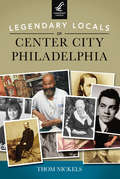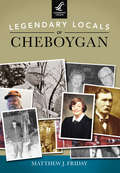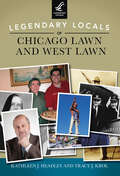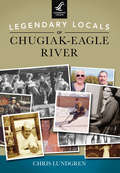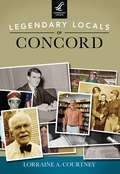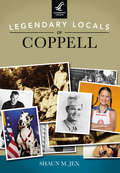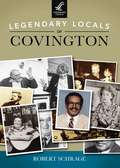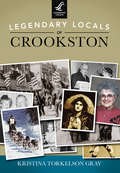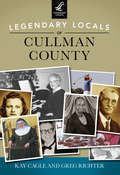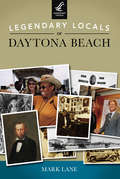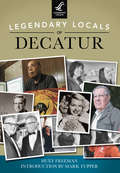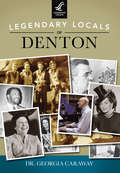- Table View
- List View
Legendary Locals of Bend (Legendary Locals)
by Hays County Historical Commission Les JoslinA fascinating mix of local legends who could be characterized as "the right people, in the right place, at the right time" arrived in Central Oregon during the past century and a half to make Bend the fascinating city it has become. Some of these people--explorer John Charles Fremont, publisher George Palmer Putnam, economist William A. Niskanen, and "World's Greatest Athlete" Ashton Eaton among them--gained national prominence and even global stature. Others were and are more ordinary people who have done and continue to do extraordinary things in an extraordinary place, a small but singular city of some 80,000 souls astride the Deschutes River at the eastern foot of the Cascade Range.
Legendary Locals of Boise (Legendary Locals)
by Barbara Perry Bauer Elizabeth JacoxBoise of the 21st century is very different from the tiny community established in 1863 at the crossroads of the Oregon Trail and the road to the Boise Basin gold mines. Originally known as "Boise City," it existed as a distribution center for supplies and fresh food for miners. The development of irrigated agriculture and the expansion of transportation networks during the 20th century and an influx of pioneers from many regions of the United States helped the city grow into a technology center during the 21st century. Early residents like Tom and Julia Davis helped create a city filled with green parks and walking paths; author and illustrator Mary Hallock Foote brought Boise to the attention of the nation with her writing and illustrations; businessmen J.R. Simplot and Joe Albertson established local businesses that grew to national companies. The music of Curtis Stigers, the literature of Anthony Doerr, and the athletic prowess of Kristin Armstrong have helped focus attention on Boise, which is now recognized as one of the country's most livable communities.
Legendary Locals of Boston's South End (Legendary Locals)
by Hope J. ShannonFrom the South End's early years as an upper- and middle-class residential district to its time as an immigrant and rooming house neighborhood and then to its recent urban renewal, residents have shaped its legacy and its place within the city of Boston. Locals have worked in common to make the South End a safe and vibrant community for over two centuries. Notables such as architect Gridley J.F. Bryant, preservation advocate Arthur Howe, and pedestrian advocate Ann Hershfang contributed immensely to the built environment. Residents like settlement house leader Robert Woods, immigrant and author Mary Antin, politician and activist Mel King, urban gardener Betsy Johnson, and lawyer Harry Dow, to name a few, shaped minds and lives alike. Add to their ranks artists like Allan Rohan Crite and Kahlil Gibran, jazz club owner Joseph Walcott, longtime restaurateurs such as the Foley and Manjourides families, and bar owner and gay rights advocate Leo Motsis and a true picture of the South End's history and diversity begins to emerge.
Legendary Locals of Bozeman (Legendary Locals)
by Rachel PhillipsFrom its inception as a supply town during Montana's gold rush in the 1860s, Bozeman has attracted visionaries, leaders, and pioneering thinkers. Bozeman's first mayor, John V. Bogert, established a precedent for keeping the city clean, safe, and orderly. City commissioner and tireless worker Mary Vant Hull spearheaded efforts to build a new library and to expand local parks and trails, and early physician Dr. Henry Foster successfully performed one of the first caesarean sections in Montana. Incredibly talented outdoor advocates and athletes like mountain climber Alex Lowe and long-distance runner Ed Anacker have complemented Bozeman's outdoor lifestyle. An emphasis on art, music, and culture began in the 1860s with piano and voice sensation Emma Weeks Willson. Today, artist Jim Dolan's sculptures are enjoyed all over town, and illusionist Jay Owenhouse wows children and adults with his live shows. Inspiring individuals like Cody Dieruf, who passed away from cystic fibrosis at the age of 23, and dedicated streetcar driver Larry O'Brien have added kindness and courage to local life.
Legendary Locals of Bristol
by Christy NadalinThe story of Bristol is the story of America, played out on the small stage of a lobster claw-shaped peninsula at the heart of Narragansett Bay. From the massacre and displacement of the first Americans to the rise of the merchant class; exploration; slavery; war and peace; the Industrial Revolution; waves of immigration--all these wildly disparate facets of the American experience have been represented and reflected within these 20 square miles. Bristol has been home to patriots and pirates; ministers and murderers; captains who dominated at the helms of whalers, battleships, and 12-meter sailboats; larger-than-life industrialists; Hollywood and Broadway royalty; artists, writers, musicians, and culinary visionaries. But the bulk of the threads in Bristol's remarkable tapestry are not bold-colored silk, bright metallic, or rich cashmere--most are simple and natural, unremarkably structured and hued, but each one quietly doing its part to form the strong, tightly-woven foundation of this very special place.
Legendary Locals of Brookline (Legendary Locals)
by Jennifer CampanioloFor its first 75 years, Brookline was a bucolic area of Boston, with rolling hills and low-lying salt marshes. Named �Muddy River� by its residents after a shallow tidal estuary bordering Roxbury, Brookline had no more than 50 families inhabiting it when it was incorporated as an independent town on November 13, 1705. Long regarded as a liberal, progressive community, Brookline is a model of how an effective town government can positively impact the life of its citizens. Brookline boasts numerous Nobel Prize winners�doctors, scientists, and researchers who have made enormous strides in their fields. Brookline shares Boston�s strong literary tradition, with residents like poet Amy Lowell and mystery writer Dennis Lehane. Brookline�s pedestrian-friendly infrastructure, with many residents who eschew cars and shop locally, attracts many small-business owners such as Dana Brigham and Seth Barrett. Brookline has been home to a number of sports luminaries like Larry Bird, Terry Francona, and Robert Kraft. Famous politicians include the 35th president, John F. Kennedy, who was born in Brookline; former governor Michael Dukakis; and New York mayor Michael Bloomberg. Legendary Locals of Brookline tells their stories, as well as the stories of some of the lesser-known heroes and humanitarians who make Brookline a great place to call home.
Legendary Locals of Broomfield
by Carol TurnerThe city of Broomfield had its beginnings in the "howling wilderness" of the late 1850s. At first, the settlement was little more than two stage stops along a treacherous route to California. The Church family operated Church's Crossing Stage Stop, a day's ride from Denver on the Overland Trail. Over many years, other pioneer families settled in: the Graves and Crooks families, the Browns, Nissens, Wrights, Koziseks, Archers, Hansens, Shaws, Brunners, and more. Some of these families claim five or six generations in the area. A century passed before Broomfield began to grow into the city it is today. In the late 1950s, a group of investors began building Broomfield Heights. As young families began moving in, the farm community was transformed into a suburban city, guided by local notables such as Don DesCombes, George Di Ciero, and others. Perhaps the most admirable aspect of the city's history is the enormous amount of work done by community-minded volunteers. Their story is one of selfless enthusiasm, of hard work with no reward except a better place to live.
Legendary Locals of Buckeye
by Verlyne MeckIn 1884, Malie Monroe Jackson began and named a canal Buckeye in honor of his native state, Ohio, the Buckeye state. In 1886, Thomas Newton Clanton added 10 miles to the canal. The following year, he applied for a post office, and on March 10, 1888, the post office, named Buckeye, was established. Clanton platted a townsite and named the town Sidney, though why he chose that name remains a mystery. Beginning in 1910, advances in transportation put the community on the map, and Sidney became Buckeye. Hugh Watson, founder of the Buckeye Valley Bank, became the town's first mayor in 1929. On January 1, 2014, Buckeye became the newest city in Arizona. This newest volume also celebrates today's Buckeye settlers, such as Levi Beard, Tony Youngker, Clemie Arnold, and Bob Doster, DVM, updating Buckeye's colorful history of notable residents.
Legendary Locals of Cabarrus County
by Michael EuryIn calling for the region's separation from Mecklenburg County in 1792, John "Pioneer Paul" Barringer set a high-spirited standard for future legendary locals of the nascent Cabarrus County. New communities flourished on the former homesteads of Robert Harris and Paul M. Dayvault, and the county was subsequently transformed by devoted civic leaders such as John Washington Carriker, Jonas Cook, A.L. Brown, J. Carlyle Rutledge, Martha Melvin, and Allen T. and Ella Mae Small. Cabarrus County citizens, like Glenn McDuffie, the famous "kissing soldier" of World War II; Corine Cannon, the first African American woman to work in the textile mills; and Margaret Hagerty, the Guinness World Records-holding senior citizen marathon runner, often tread where others recoil. Kannapolis-born Ralph Earnhardt started a racing dynasty here, while other natives found their fortunes elsewhere, including record producer Marshall Sehorn, NFL superstar Natrone Means, and broadcaster Beth Troutman. Cabarrus County's people have always been its most valuable resource, and their inspirational and exhilarating stories are collected in this keepsake edition.
Legendary Locals of Carlsbad
by Donna Blake Birchell Southeastern New Mexico Historical SocietyBorn from opportunity and a promotional scheme hatched by founding father Charles B. Eddy, Carlsbad started life as a tent city on a desolate landscape. As the investment money started to flow, the Pecos River was harnessed through the creation of irrigation, which turned the region into a rich, fertile valley. As tuberculosis swept the nation, hundreds of new settlers arrived in Carlsbad for the arid climate. Legendary Locals of Carlsbad celebrates their descendants who forged the community of today. Learn about socialite Cesarine Graves, daredevil and "Mr. Welcome" Frank Kindel, actors Dan Blocker and Bruce Cabot, drag racer Dick Harrell, newscaster Linda Wertheimer, astronaut F. Drew Gaffney, and baseball star Cody Ross, to name but a few. Included also are the tales of the trials and heroism shown and faced by all the veterans of wars that Carlsbad provided, especially the World War II veterans of the Bataan Death March, the Vietnam War, and the wars in Iraq and Afghanistan.
Legendary Locals of Carlsbad (Legendary Locals)
by Cynthia Mestad JohnsonA collision of cultures in a seaside resort community, Carlsbad sits on a seven-mile stretch of white-sands beach idyllically located on the Pacific coast of north county San Diego. The idea of Carlsbad began in the late 1880s when two small groups of entrepreneurs ascended, simultaneously, from both the north and the south. The first group discovered natural mineral springs, which they promoted to tourists as having healing powers. As a result, the town became a very popular resting point for the rich and famous when traveling by train from Los Angeles to the famed Del Mar horse races. Subsequently, the Mexican Revolution began to the south and drove a second group of visionaries to Carlsbad. Thus, the quaint downtown area, known as the Village, was created along with a vibrant Barrio. Incorporated in 1952, Carlsbad remains, today, a tight-knit community of multigenerational and uniquely talented locals.
Legendary Locals of Carmel (Legendary Locals)
by Debra Haskett MayEarly Carmel settlers Silas Moffitt and William Kinzer found the area to be abundant for hunting and the soil rich for farming. Quaker in origin, the town's quest for importance in education was forefront and remains so today. With other dedicated leaders through a time of rapid growth in the mid-20th century, Robert Hartman and Dale Graham set the standard to make Carmel High School a respected rival in academic, sports, and extracurricular competitions. Beautiful art galleries, anchored by the Evan Lurie Building, dot the rejuvenated downtown Arts & Design District where Colonel Trester's blacksmith shop and O.W. Nutt's hardware store once stood. A far cry from tented summer church revivals, world-class musicians and performers now take the stage of the Palladium, an acoustically perfect and visually magnificent performing arts center. Visionary mayor James Brainard seeks a sixth term and hopes to continue on the same path of growth and renewal. The city has been voted one of America's best places to live, and Carmel's varied and colorful residents have been proving this since the 1830s.
Legendary Locals of Carmel-by-the-Sea
by Lisa Crawford WatsonA place whose history has long been a source of fable and fascination, Carmel-by-the-Sea is a community whose ancestors summered by the sea and ultimately stayed through the seasons. After founders Frank Powers and Frank Devendorf populated the once-barren potato patches with artists and academicians, it became a place defined as much by legends and landscape as by the characters who came to Carmel. Whether it is the clear light that attracted photographers Edward Weston, Ansel Adams, Doug Steakley, and Bob Kolbrener; the whisper in the trees, the rhythm of the waves, and the stillness at dawn that seduced writers Mary Austin, Robinson Jeffers, Jack London, Bob Campbell, Rick Masten, and Jane Smiley; or the unbridled beauty in a majestic mountain, surging sea, or verdant valley that drew in artists Mary DeNeale Morgan, William F. Ritschel, E. Charlton Fortune, Mari Kloeppel, Carol Chapman, and Loet Vanderveen, the truth is that Carmel-by-the-Sea gets in one's soul and makes its home there.
Legendary Locals of Center City Philadelphia (Legendary Locals)
by Thom NickelsPhiladelphia is a hard mistress when it comes to honoring native talent, and the city has more than its fair share of notable figures. Consider colorful politicians like Frank Rizzo and Richardson Dilworth, international celebrities like Grace Kelly, sports legends like Connie Mack, Philadelphia Museum of Art icons like Anne d'Harnoncourt, or national radio personalities like Terry Gross. Business tycoons such as John Wanamaker and Russell Conwell, founder of Temple University, made many contributions to the city. Pearl Buck, author of The Good Earth, and Christopher Morley, America's G.K. Chesterton, created legacies of their own. Other legends like the nearly forgotten Agnes Repplier, a world-famous essayist and contemporary of Henry James, and poet Daniel Hoffman, the designated US poet laureate in 1973-1974, have helped enrich the city's literary reputation. There are Marian Anderson, Mario Lanza, and Hollywood actor Kevin Bacon, whose fame is equaled by his city planner father, Edmund. Architects like Frank Furness, Louis Kahn, and Vincent Kling helped transform the city into an international destination. And there are many notables looming outside the margins of this book, waiting for their day of discovery.
Legendary Locals of Cheboygan
by Matthew J. FridayFounded as a lumbering town in the mid-1800s, Cheboygan has transformed over the years to be something much less simplistic and much more dynamic; so, too, have its people. While some of Cheboygan's residents played important roles in business or commerce, others made their mark through philanthropic work, service to the community, or just by their demeanor. History is as much about people as it is about events--people like Gordon "Scoop" Turner, who came to Cheboygan for a few months but ended up staying for a lifetime. There are businessmen like Millard D. Olds, who became one of the most successful lumbermen at a time when others were leaving town, and George M. Humphrey, the 55th treasurer of the United States. An eye towards the community has also made some residents legendary, such as Joyce and Quincy Leslie. And, of course, there are those whose history is shrouded in controversy, including Sheriff Fred Ming, under whose authority a Native American village was burned to the ground. Whatever their story, these locals have contributed to the character and history of Cheboygan.
Legendary Locals of Chicago Lawn and West Lawn (Legendary Locals)
by Kathleen J. HeadleyFrom West Palm Beach's beginnings as service town to Palm Beach, Standard Oil tycoon Henry Morrison Flagler's resort village, the city has evolved into a trendy art, cultural, and shopping mecca. Palm Beach County's largest city serves as county seat and center of business, government, and commerce. Taming America's last frontier saw the industriousness of pioneers and settlers such as Marion Gruber, the Potter brothers, George Lainhart, and Max Greenberg guide the "Cottage City" of yesteryear to today's gleaming metropolis. Meet many of West Palm Beach's pioneers, civic leaders, educators, business leaders, and entrepreneurs. Learn about the heroes, celebrities, philanthropists, and even the villains who have contributed to the mosaic of West Palm Beach.
Legendary Locals of Chugiak-Eagle River
by Chris LundgrenHomesteading in Alaska was not an obvious lifestyle choice for most people in post-World War II America. In an age of gleeful consumerism, early settlers of Chugiak-Eagle River made a decision to live simply. Yet a simple life and an easy one were two different things. Many raised their own crops and a few, such as the Pippels, the Tatros, the Glenn Briggses, and the Vanovers, created larger-scale farming ventures. Other entrepreneurs, such as Paul Swanson, thrived in the frontier environment, taking on multiple enterprises to fill gaps in the area's services. Out of this can-do atmosphere sprang a number of artists, musicians, and performers. The Chugiak Belles dance group revved up audiences at the annual Spring Carnival, and the Chugiak Players staged a variety of dramas and comedies. Eagle River homesteaders Arthur and Eleanor Braendel helped found the Anchorage Symphony Orchestra and performed with them for 60 years. Radio host and homesteader Ruth Briggs sang and traveled with the original Anchorage Concert Chorus. As the area matured and schools grew, athletes began to thrive, creating their own legacy. More legendary locals are being minted every day.
Legendary Locals of Concord (Legendary Locals)
by Lorraine A. CourtneyThe land now called Concord was originally inhabited by the Abenaki people and the Penacook tribe. Concord's first settlers, such as Ebenezer Eastman, began laying out the Plantation of Penacook, as it was known in 1725, along the fertile fields of the Merrimack River. It was incorporated in 1734 as Rumford and then renamed to Concord by Gov. Benning Wentworth in 1765. Concord experienced a surge in transportation and manufacturing in the 19th century, producing the Concord Coaches, Prescott Pianos, and steam boilers. As Concord celebrates its 250th anniversary, the city flourishes as the state capital and has a thriving community of restaurants, entertainment, and culture for all to enjoy. It retains its town sensibility as it plans for the continued growth of the local economy. Today's civic leaders, like Byron Champlin and James Carroll, work conjointly with business leaders, such as Tom Arnold of Arnie's and Juliana Eades of the New Hampshire Community Loan Fund, to build and enhance Concord's cultural, social, and economic identity.
Legendary Locals of Coppell
by Shaun M. JexCoppell has produced a wealth of personalities that could have leapt from the pages of a novel. The town's early days brought John and Sarah Stringfellow, who helped found the town's oldest church, and Josiah and John Record, a father-and-son duo who were victims of lynching. The coming of the Cottonbelt Railroad created the mystery of town namesake George Coppell. The town was home to farmers like domino-loving Buren Ledbetter and sharecropper W.A. Ottinger. It had its own "Floyd the Barber" (Floyd Harwell), as well as Jo Jackson, the librarian known to most as the "Bird Lady of Coppell." The town has produced a wealth of heroes like Carroll Kirkland, who was killed in World War II, and Jacob Schick, a decorated veteran of the Iraq War. It is also a town that has turned tragedy into triumph through stories like Todd and Tara Storch, who transformed the pain of their daughter Taylor's death into the life-giving charity Taylor's Gift. Together their stories tell the story of Coppell, a place that at its heart will always be a small town.
Legendary Locals of Covington (Legendary Locals)
by Robert SchrageCovington was a natural place for people to settle. Located on the banks of the Ohio and Licking Rivers, it developed quickly as the urban core of northern Kentucky. Sitting just opposite of Cincinnati, Ohio, it was a great location for travel by both animals and people. Originally owned by Thomas Kennedy, the land was ultimately purchased by Thomas Carneal and John and Richard Gano, and thus the city of Covington was founded in 1815. Not long after its establishment, railroads made Covington their home and many other businesses followed. By 1850, it was the second-largest city in Kentucky. Over its 200 years, Covington has seen many people play a role in its history, development, and reputation. Some are great business and community leaders. Others made tremendous contributions to the arts, and some are notorious. A community is defined more by its people than its buildings and streets. The individuals who have lived and worked in Covington provide a colorful insight into its past. From its founding until the present day, these individuals are a fascinating look into the city's history.
Legendary Locals of Crookston
by Kristina Torkelson GrayCrookston is in the heart of the fertile Red River Valley. Railroad baron James J. Hill positioned the city to be a hub of transportation, so Civil War veterans and railroad workers settled Crookston first. At Hill's behest, a long tradition of learning how to "farm smart" started with the Northwest School of Agriculture in 1906. Facing a short growing season, farmers stayed close to the soil and invented better implements to harvest the area's bounty. The tradition of improving technology continues from the century-old practices begun at the Experiment Station. Currently, precision agriculture is taught at the University of Minnesota, Crookston's "laptop university." Familiar family names from Crookston's retail sector have prevailed throughout the farmers' cycle of boom and bust. Many other talented personalities shine through, especially those skilled in sports and music. Also included in this volume are unsung heroes for their acts of kindness and volunteerism.
Legendary Locals of Cullman County (Legendary Locals)
by Greg Richter Kay CagleIn search of opportunity and freedom from oppression, European emigrants boarded ships, leaving behind their ancestral homes. They carved new lives from the unknown wilderness in the American South. The Speegle family settled in what would become southwest Cullman County, and the Brindley family claimed lands to the north. From the historic Streight's Raid exploit of the Civil War to the agricultural and social development of this region of northern Alabama, these early pioneers marched into history. In 1865, Col. Johann G. Cullmann, who was disillusioned with the anarchism in his native Germany, also sought new opportunity in America, eventually settling in Alabama. After being enticed by Colonel Cullmann's descriptive words of the area's virgin timber and fertile soils, ?ve German families joined him. Encouraged by what they found, optimism flourished, word spread, and Cullman County's destiny was set. Its growth has been constant, and, today, its expansion is propelling the area to new heights of economic prominence.
Legendary Locals of Daytona Beach
by Mark LaneSince the 1920s, Daytona Beach has sold itself as "The World's Most Famous Beach," which, while not literally true, does suggest a city with a big personality and large plans. The people in these pages contributed to that personality and made those plans. These people include Matthias Day, the Ohio industrialist, educator, inventor, and newspaper editor who founded and gave his name to the new city in 1876; Mary McLeod Bethune, the daughter of former slaves, who founded the university that bears her name "with five little girls, a dollar and a half, and faith in God"; Bill France Sr., the race driver and promoter who took stock car racing from the beach sands to a state-of-the-art track and built a racing empire; and his son, Bill France Jr., who turned NASCAR into a national pastime. Other notable Daytonans include the builders, writers, artists, rockers, promoters, business founders, educators, journalists, politicians, pioneers, bootleggers, philanthropists, sports stars, and even a dog that made the city what it is today. They come to life in historical photographs from the Halifax Historical Museum, the Florida Archives, and files of the Daytona Beach News-Journal.
Legendary Locals of Decatur (Legendary Locals)
by Huey Freeman Mark TupperA working-class city of 75,000 people on the banks of the Sangamon River and its largest lake, Decatur has a reputation for outstanding individuals with a strong community spirit and an unashamed sense of patriotism. To borrow a phrase from Adm. Chester Nimitz, in Decatur, uncommon dedication is a common virtue. Harold Miller fought at Iwo Jima with a Marine tank battalion, before serving 32 years on the Decatur Police Department. Wayne and Leslie Kent, ministers at First Christian Church, risked their freedom to bring music and encouragement to oppressed believers in the Soviet Union and Poland. George Halas, a Navy veteran, was player-coach for the Decatur Staleys football team (later the Chicago Bears), a charter franchise in the professional association that would become the NFL. Bob Fallstrom, a World War II soldier before working as a newspaper reporter and editor in Decatur for more than 65 years, has promoted numerous community causes. Legendary Locals of Decatur pays tribute to those who have made this community truly unique.
Legendary Locals of Denton (Legendary Locals)
by Dr Georgia CarawayDenton, Texas, was founded in 1857 because residents needed a location near the geographic center of Denton County to house a county seat. The city is located 39 miles north of two larger cities, Dallas and Fort Worth, and the three of them form what is often referred to as the "Golden Triangle." Denton, the peak of that triangle, is the "North Star," and its residents, past and present, certainly are superstars--superstars such as Bob Rogers, the beloved "Piano Man;" Mary Evelyn Blagg Huey, a quintessential leader; and Hal Jackson, an ace war hero and lawyer. Their accomplishments burst forth from the chapters of this book to outshine others with their generosity, talents, skills, community activism, adventurous spirits, energy, civic pride, business acumen, courage, and creativity. Citizens of Denton are proud to say, "Our history defines our community." The images and words between these covers illustrate why it should be added, "And our people define our history."
